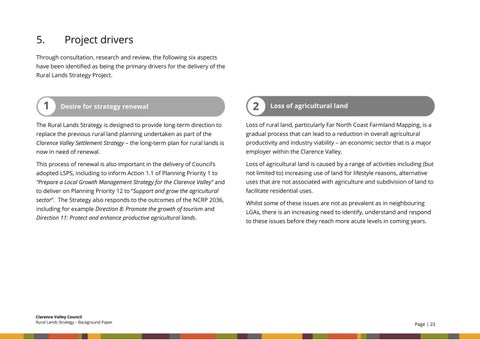5.
Project drivers
Through consultation, research and review, the following six aspects have been identified as being the primary drivers for the delivery of the Rural Lands Strategy Project.
5.1
Strategy renewal
5.2
Loss of agricultural land
The Rural Lands Strategy is designed to provide long-term direction to
Loss of rural land, particularly Far North Coast Farmland Mapping, is a
replace the previous rural land planning undertaken as part of the
gradual process that can lead to a reduction in overall agricultural
Clarence Valley Settlement Strategy – the long-term plan for rural lands is
productivity and industry viability – an economic sector that is a major
now in need of renewal.
employer within the Clarence Valley.
This process of renewal is also important in the delivery of Council’s
Loss of agricultural land is caused by a range of activities including (but
adopted LSPS, including to inform Action 1.1 of Planning Priority 1 to
not limited to) increasing use of land for lifestyle reasons, alternative
“Prepare a Local Growth Management Strategy for the Clarence Valley” and
uses that are not associated with agriculture and subdivision of land to
to deliver on Planning Priority 12 to “Support and grow the agricultural
facilitate residential uses.
sector”. The Strategy also responds to the outcomes of the NCRP 2036, including for example Direction 8: Promote the growth of tourism and Direction 11: Protect and enhance productive agricultural lands.
Clarence Valley Council Rural Lands Strategy – Background Paper
Whilst some of these issues are not as prevalent as in neighbouring LGAs, there is an increasing need to identify, understand and respond to these issues before they reach more acute levels in coming years.
Page | 23














